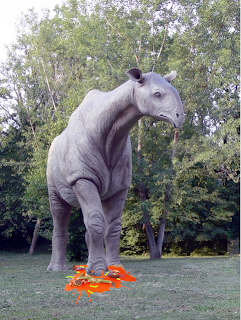Theories on Pedal Arrangement and Seasonal Adaptation in the Yeti
by Dr. Bhasmati Rhyce, University of Utter Pradesh
In my opinion, western science has to date failed to take into account some plausible theories regarding the Yeti and why no specimens have so far been captured. I believe the answer to this question is twofold: that this hominid possesses a unique foot arrangement and further undergoes chromatic seasonal changes.
I now accept the Sherpa legend of the Yeti having its feet pointing backwards to be quite plausible, despite the fact that this phenomenon is as yet unknown among any of the Earth's biota. It can quite conveniently explain why tracking this creature has so far yielded no positive results – those tracking it have been going in the wrong direction! Indeed, during my 2009 expedition to the Himalayas (accompanied by Dr. Guptil Singh of the University of Mysore and Prof. Baba Rum Raisin of Sacred Cow College) my colleagues and I were continually confounded by positively-identified Yeti tracks leading absolutely nowhere. One might even speculate - given these hominids presumed intelligence - they may engage in a hearty horselaugh by misleading their presumed captors in such a manner.
I further believe the Yeti exhibits chromatic variance according to the seasons, much as do other alpine taxa such as the ermine and ptarmigan. That is, the Yeti's hide is brown in summer and white in winter. Based on this speculation, we may now accept reports dismissing Yeti sightings as Himalayan sun bears to be false. This should have already been evident as no Yeti has the distinctive “Y”-shaped chest marking characteristic of these bears, nor do they possess an obscenely long tongue.
Taking these new theories into account, my colleagues and I are planning another Yeti expedition to Nepal in the winter of 2013, this time dressed entirely in white and planting our transect lines while walking in reverse.
 |
| Dr. Rhyce during his failed 2009 expedition to sight a Yeti in Nepal |

























